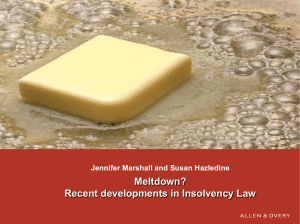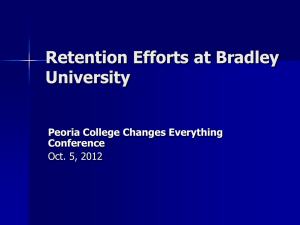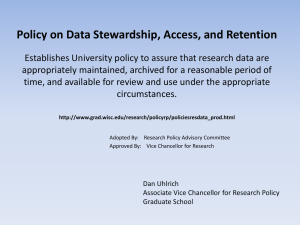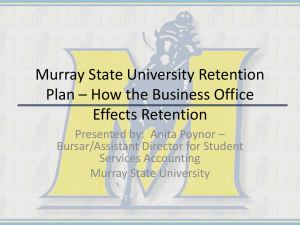Late Payment Legislation
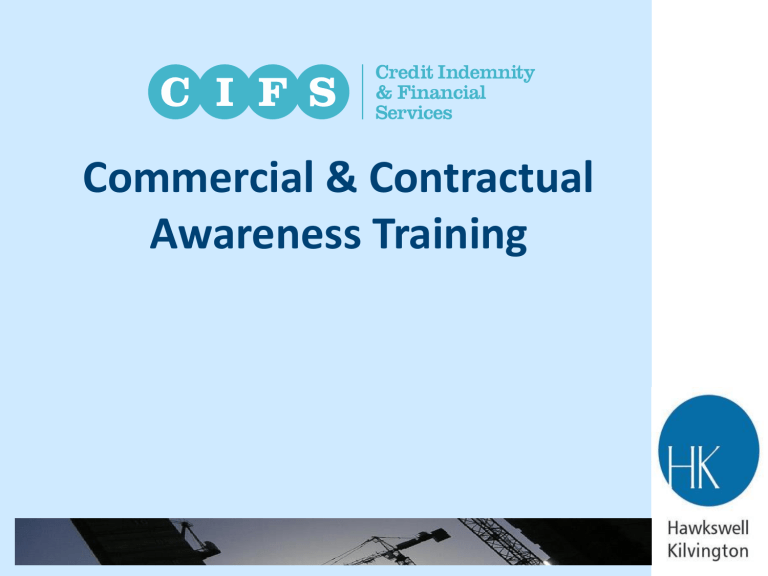
Commercial & Contractual
Awareness Training
Overview
•
Getting the contract right – avoiding problem payment provisions.
•
Maximising payment.
•
Recovering retention.
•
Minimising insolvency risks.
Getting the Contract Right –
Avoiding Problem Payment
Provisions
Problem Payment Provisions
•
Disruption to cashflow.
•
Vague payment terms.
•
Conditions precedent to payment.
•
Set-off clauses.
•
Conclusive provisions.
Disruption to Cashflow
• Look out for regular interim payments at fortnightly or monthly intervals.
• Lengthy payment terms can mean a long lead-in period between starting work and getting paid – consider an advance payment to overcome this problem.
• Interim payments linked to milestones rather than monthly dates can disrupt cashflow.
• Interim payments made on a percentage basis
(rather than against progress of the works to date) can also have a negative impact on cashflow.
Vague Payment Terms
• Is it clear when you will be paid and how much you will be paid?
• Is it clear how the payment process works e.g. how do you apply for payment?
• If it is not clear how the payment process works, disputes are more likely to arise.
• Don’t forget retention – is it clear how much retention is being withheld and when retention will be released? If you don’t understand when your retention will be released, how can you claim for it?
Conditions Precedent
• A condition precedent is a clause which provides that one party is only entitled to its contractual right if a specific condition is fulfilled.
• Failure to comply with the condition carries the sanction of losing that contractual right.
• A condition precedent has the effect of excluding what might otherwise be a valid claim or entitlement.
Conditions Precedent
• Conditions precedent to payment are extremely common.
• Examples include:
• No payment until a parent company guarantee/performance bond is provided.
• No payment if collateral warranties are not provided.
• No payment if key information like VAT registration numbers and insurance certificates are not provided.
• Also common are clauses allowing the payer to deduct a specified sum for failure to comply e.g. £10,000 per warranty.
Assessing Conditions Precedent
1.
2.
3.
4.
Check the contract for conditions precedent.
• Note: the contract may not use the words
“condition precedent”. Phrases such as “provided that”, “on condition that”, “subject always to” and
“if” can create a condition precedent.
Can you comply with the conditions?
What are the consequences if you fail to comply?
Can you negotiate…
-
to make the conditions less onerous?
to have the clause deleted altogether?
Set-Off Clauses
• The right of set-off permits a debtor to reduce the sum he owes to a creditor by deducting any money which is owed to him by the creditor.
• The right of set-off arises automatically in law when a claim and a cross-claim are so closely connected that it would be unjust to enforce one claim without taking the other into account.
• This usually covers claims and cross-claims arising under the same contract.
• However, relying on the implied legal right of set-off can create uncertainties.
Set-Off Clauses
• Many contracts contain a clause giving an express contractual right of set-off. The benefit to the paying party is that:
• It provides certainty – you know you can exercise the right of set-off because you are not relying on an implied legal right.
• An express clause can allow:
• set-off between different contracts;
• set-off of sums that are not yet due; and
• set-off of estimates.
Set-Off Clauses
• From the payee’s perspective, set-off clauses should be reviewed carefully.
• Cross-contract set-off can result in a loss of control of cash flow on specific projects. Avoid these if you do a lot of work for one payer under different contracts or under a framework agreement.
• Set-off of estimates is open to abuse.
• Payees should negotiate the terms of set-off clauses so that they only allow the deduction of reasonable and proven costs.
Maximising Payment
Maximising Payment
• Applying for payment properly.
• Good credit control.
• Charge interest.
• Understanding your rights under the Late
Payment legislation.
• Suspension for non-payment.
Applying for Payment
• Ensure payment applications are in on time and in the correct format.
• Provide proper substantiation of costs claimed.
• Ensure instructions to carry out variations have been given in writing.
• Get daywork sheets signed on the day the work is carried out and submit them with applications.
• Ensure VAT invoices are submitted promptly.
Good Credit Control
• A good credit control system cannot be underestimated.
• Diarise due dates for payment and final dates for payment.
• If the contract requires the payer to issue a certificate or notice confirming the amount due, chase this if it is not issued.
• Chase overdue payments persistently.
Charge Interest
• Check the contract for a rate of interest for late payments.
• Calculate the applicable interest and send chaser letters setting out the interest that has now accrued.
• Consider offering to waive your right to interest in return for prompt payment of the overdue sum.
Late Payment Legislation
• Late Payment of Commercial Debts (Interest)
Act 1998.
• Only applies where the contract does not contain a “substantial remedy” for late payment.
• Allows the payee to charge interest at 8% above the Bank of England base rate on late payments.
Late Payment Legislation
• What is a “substantial remedy”?
• Previously the focus has purely been the interest rate specified in the contract.
• JCT contracts contain an interest rate of 5% above the base rate - this is widely regarded as a substantial remedy.
• In the case of Yuanda (UK) Co v WW Gear
Construction (2010), the interest rate was 0.5% above the base rate. The court held that this was not a substantial remedy and replaced it with the statutory rate of 8% over base.
Late Payment Legislation
• Where the Late Payment of Commercial Debts
(Interest) Act 1998 applies, payees have a right to claim a fixed sum of compensation for late payment in addition to statutory interest:
• £40 for debts of up to £999.99.
• £70 for debts from £1,000.00 to £9,999.99.
• £100 for debts above £10,000.00.
Late Payment Legislation
• The Late Payment of Commercial Debts
(Interest) Act 1998 was recently amended by the Late Payment of Commercial Debts
Regulations 2013.
• Only applies to contracts entered into after 16
March 2013.
• Creates two new rights:
• A right for payees to claim the “reasonable costs” incurred in recovering the debt.
• A right to claim statutory interest after 60 days.
Late Payment Legislation
Recovery of Reasonable Costs
• The right to claim the “reasonable costs” of recovering a debt only arises when:
1. the Act applies i.e. when there is no alternative “substantial remedy” for late payment in the contract; AND
2. the fixed sum of £40, £70 or £100 (depending on the value of the debt) does not cover the payee’s reasonable costs of recovering the debt.
Late Payment Legislation
• Meaning of “reasonable costs” is not clear.
• Probably only covers costs incurred prior to formal proceedings, such as administrative costs and possibly the cost of preliminary legal assistance such as solicitors’ letters.
• Unlikely to cover adjudication/legal costs:
• The Construction Act prohibits the recovery of legal costs from the other party in adjudication.
• The detailed rules relating to legal costs could be undermined if the Regulations allowed for automatic recovery of costs.
• Keep a record of costs incurred.
• Doubtful that payees will voluntarily pay “reasonable costs”.
Late Payment Legislation
Right to claim statutory interest after 60 days
• Under the Regulations, statutory interest will begin to accrue 60 days (or 30 days if the payer is a public authority) after whichever is the latest of:
• the day the payee performs the obligations to which payment relates;
• the day the payee submits a claim for payment; or
• the day the payer verifies or accepts goods or services provided (where the contract includes a verification or acceptance procedure).
• The effect of the Regulations is to impose a limit on how long a payment period can be before statutory interest begins to accrue.
Late Payment Legislation
• Note: the Regulations say that statutory interest will start to accrue after 60 days.
• They DO NOT say that payers have to pay invoices within 60 days.
• Payers can have longer payment periods and just risk being faced with a claim for interest on any period in excess of 60 days.
Late Payment Legislation
• 2 important exceptions to the 60 day rule.
1. Only applies where statutory interest applies i.e. not in cases where there is a contractual
“substantial remedy” for late payment.
2. Does not apply where the contracting parties have
“expressly agreed” a payment period longer than 60 days and that period is not “grossly unfair”.
• Not clear what is meant by “expressly agreed” – do standard terms and conditions count?
• The Regulations state that any payment period that is a “gross deviation from good commercial practice and contrary to good faith and fair
dealing” may be grossly unfair.
Late Payment Legislation
• Will the view of what constitutes a “substantial remedy” change in light of the Regulations?
• The Act and the Regulations offer a wide range of remedies in addition to interest.
• Payees may be able to argue that an interest rate alone does not constitute a “substantial remedy” and that contracts must provide more generous remedies in order to effectively exclude the Act and the Regulations.
• No case law on this issue yet.
Suspension for Non-Payment
• Your rights in terms of suspension for nonpayment will differ depending on whether the contract was:
• entered into before 1 October 2011 (and is therefore governed by the Housing Grants,
Construction & Regeneration Act 1996); or
• entered into on or after 1 October 2011 (and is therefore governed by the Housing Grants,
Construction & Regeneration Act 1996, as amended by the Local Democracy, Economic
Development & Construction Act 2009).
Suspension for Non-Payment
• Pre 1 October 2011:
• Must give at least 7 days’ notice of intention to suspend performance, stating the ground or grounds for suspension.
• Have to suspend performance of your obligations under the contract in their entirety.
• Entitled to an EOT for the period of suspension.
Suspension for Non-Payment
• Post 1 October 2011:
• Must give at least 7 days’ notice of intention to suspend performance, stating the ground or grounds for suspension.
• Can suspend any or all of your obligations under the contract.
• Entitled to an EOT for the period of suspension and for any period of de-mobilisation/remobilisation.
• Entitled to recover “a reasonable amount in respect of costs and expenses reasonably incurred” as a result of the suspension.
Suspension for Non-Payment
• A word of warning – in order to suspend performance:
• The final date for payment must have passed.
• The unpaid sum must be properly due.
• Notice must have been given (check if the contract specifies a longer notice period).
• Notice must have been validly served in accordance with the notice provisions of the contract.
• Get any of these steps wrong and you face being in repudiatory breach of contract and liable to pay damages to the payer.
Recovering Retention
Recovering Retention
• Your rights in terms of recovery of retention will differ depending on whether the contract was:
• entered into before 1 October 2011 (and is therefore governed by the Housing Grants,
Construction & Regeneration Act 1996); or
• entered into on or after 1 October 2011 (and is therefore governed by the Housing Grants,
Construction & Regeneration Act 1996, as amended by the Local Democracy, Economic
Development & Construction Act 2009).
Pre-1 October 2011 Contracts
• Before 1 October 2011, the release of retention was not regulated by the Construction Act.
• For Sub-Contractors, the release of the final balance of retention was typically linked to the issue of the certificate of making good defects (or similar) under the Main Contract.
• As Sub-Contractors have no control over the making good of defects in the work of the Main
Contractor or other Sub-Contractors, it was common for Sub-Contractors to wait years after practical completion to get paid the balance of their retention.
Pre-1 October 2011 Contracts
• Sub-Contractors who consider that the release of retention is being delayed unfairly can try to rely on the case of Pitchmastic v Birse (2000):
• The release of Pitchmastic’s retention was conditional on the issue of the Main Contract
Certificate of Making Good Defects.
• No Certificate of Making Good Defects was ever issued.
• Since Pitchmastic’s works were free from defects, they argued that they were entitled to receive the balance of their retention.
Pre-1 October 2011 Contracts
• The court said:
• The only way Pitchmastic could circumvent the agreed terms of the sub-contract was if they could show Birse had actively prevented the issue of the
Certificate of Making Good Defects.
• The test to be applied is whether the Main Contractor is proceeding with reasonable diligence to make good the defects.
• Pitchmastic did not provide sufficient evidence to satisfy the test.
• It is very difficult for Sub-Contractors to rely on this case – how can you get evidence about what the Main
Contractor is doing?
Post-1 October 2011 Contracts
• Section 110(1)(1A) of the amended Construction
Act states:
“The requirement… to provide an adequate mechanism for determining what payments become due under the contract, or when, is not satisfied where a construction contract makes payment conditional on:
(a) the performance of obligations under another contract, or
(b) a decision by any person as to whether obligations under another contract have been
performed.”
Post-1 October 2011 Contracts
• Section 110(1)(1A) prohibits contractual provisions which link the release of a Sub-
Contractor’s retention to the issue of the Main
Contract making good defects certificate.
• Sub-Contracts must contain their own mechanism for release of retention.
Post-1 October 2011 Contracts
• Typically, a date for the release of each part of the retention is specified.
• Under the JCT Standard and Design & Build Sub-
Contracts, the first half of retention is released at practical completion and the remainder is released on the “Retention Release Date”.
• However, Main Contractors tend to specify dates which are far in the future to try to ensure they have received their own retention before releasing it to Sub-Contractors.
Avoiding Insolvency Risks
Avoiding Insolvency Risks
• Preliminary checks.
• Parent company guarantees.
• Project bank accounts.
• Termination for insolvency.
• Pay when paid.
• Retention of title clauses.
Avoiding the Risks of Insolvency
Preliminary Checks
• Before entering into a contract, it is essential to identify the relevant parties in the payment chain.
• It is important that you think about insolvency both up and down the contractual chain; insolvency of the Employer may stop you from being paid, whilst insolvency of your supplier may put you in delay.
• Due diligence:
• Credit checks/company searches.
• Have there been payment problems on past contracts?
• Articles in the press.
Avoiding the Risks of Insolvency
Preliminary Checks
• Possible indicators of potential insolvency:
• the Employer is a new/off the shelf/special purpose company with few assets.
• a parent company refuses to provide a parent company guarantee and does not provide any explanation for its refusal.
• a Sub-Contractor who submits an abnormally low tender.
• If due diligence reveals a potential insolvency risk, there are a number of measures which could minimise the risk of non-payment.
Avoiding the Risks of Insolvency
Parent Company Guarantee
• Typically provided by the payee (on the paying party’s insistence) as a form of protection against insolvency/breach of contract.
• Can be provided by the paying party as a form of protection against non-payment, but a payee is unlikely to have the bargaining power to insist on this.
• In the event of a breach/insolvency, the parent company steps in and fulfils the relevant obligation (usually by making payment).
Avoiding the Risks of Insolvency
Parent Company Guarantee
• Only useful if the parent company has assets and is not just a ‘holding company’.
• Provides protection against the risk that the parent company will simply wind up the company in default, leaving you with nothing.
• If a PCG is required from the payee, make it a condition precedent to payment – this will ensure the PCG is provided promptly.
Avoiding the Risks of Insolvency
Project Bank Account
• Employer makes payment into a single account and this is apportioned between the Main Contractor and Sub-
Contractors.
• Everyone gets paid at the same time.
• Often used on government projects but rare in the private sector.
• Specific contract amendments will be required to cater for a project bank account.
• Does not guard against risk of Employer insolvency.
Avoiding the Risks of Insolvency
Termination for insolvency
• Almost all contracts provide for termination upon insolvency (usually automatically).
• If you are particularly concerned about the potential insolvency of a supplier/Sub-Contractor, you could include a provision allowing you to terminate when you think insolvency is imminent.
• Ensure the contract allows you to withhold payment following insolvency and gives you wide power to set-off the costs you have incurred as a result of the termination.
Avoiding the Risks of Insolvency
Pay When Paid
• Construction Act s113 – pay when paid clauses are unenforceable except for insolvency situations.
• Essential to ensure your downstream contracts contain a pay when paid clause to protect you against the risk of upstream insolvency.
• Without an insolvency pay when paid clause:
• you won’t get paid if your Employer goes bust; but
• you will still have to pay your Sub-Contractors.
• Ensure the clause is well-drafted and provides you with adequate cover.
Avoiding the Risk of Insolvency
Retention of Title Clauses
• Put simply, a ROT clause states that property in goods or materials remain with the seller until the buyer has paid for those goods or materials.
• If the buyer does not pay, the seller may repossess the goods and re-sell them.
• There must be an express ROT clause in the contract; retention of title is not a general right at common law.
Avoiding the Risk of Insolvency
Retention of Title Clauses
• ROT clauses have their limitations:
• Where goods/materials cannot be identified as belonging to the supplier, the clause will be ineffective.
• Where goods/materials are incorporated into construction works, the clause will usually cease to have any effect (although this can depend on the degree to which the goods/materials can be easily removed from the works.
• Practically speaking, it is difficult to enter the premises of the buyer or a third party to recover the goods without risking being accused of trespass.
Avoiding the Risk of Insolvency
Retention of Title Clauses
• A good ROT clause should include:
• An obligation on the buyer to store the goods separately or ensure they are identifiable as belonging to the supplier.
• An obligation on the buyer to act as fiduciary agent and bailee in relation to the goods.
• A right to enter into the premises of the buyer to recover the goods, and a right to require the buyer to “deliver up” the goods.
• A provision allowing the buyer to sell the goods on and hold the proceeds of sale on trust for the seller.
• A list of insolvency events which bring the buyer’s right to possession of the goods to an end.

